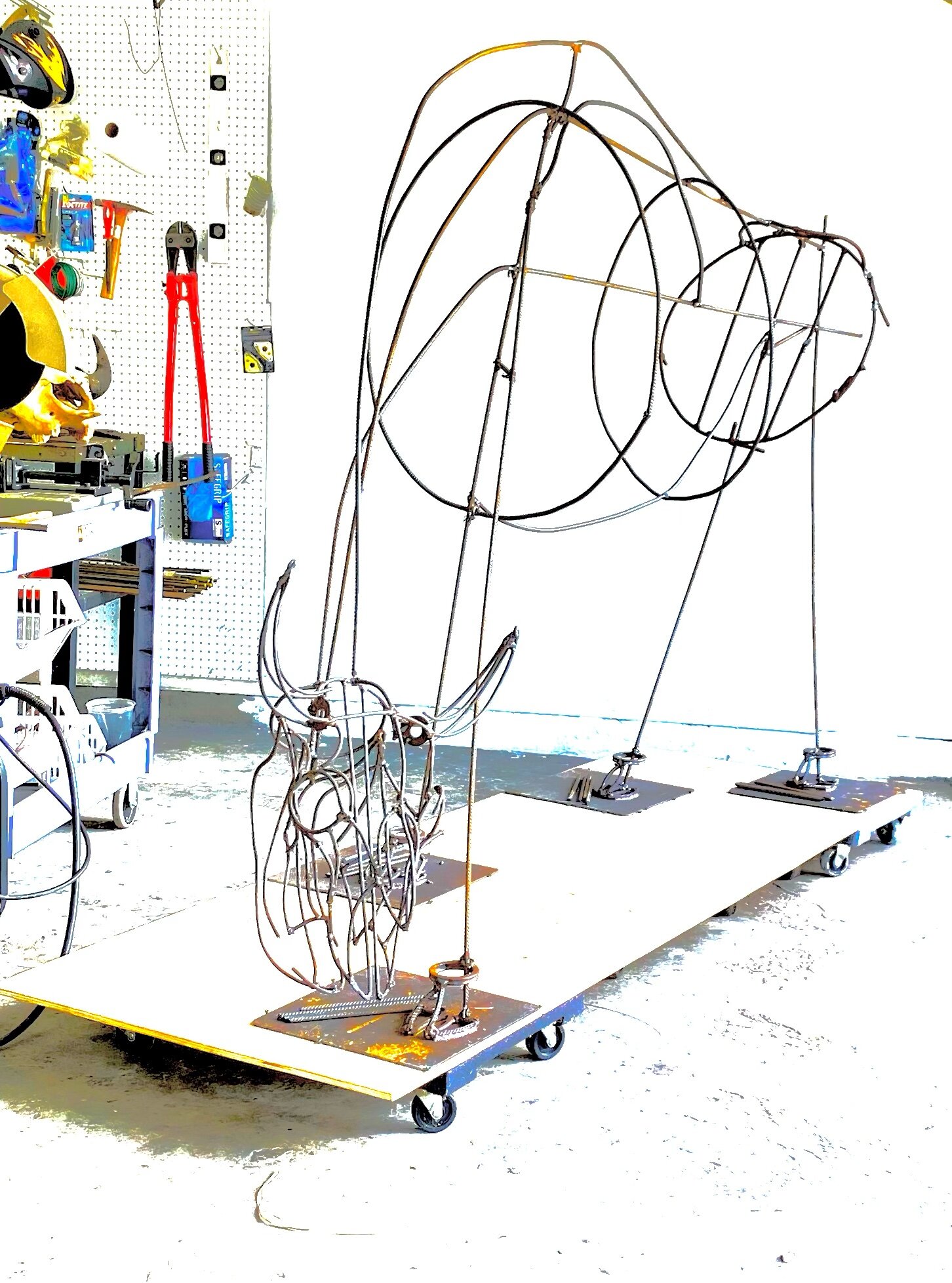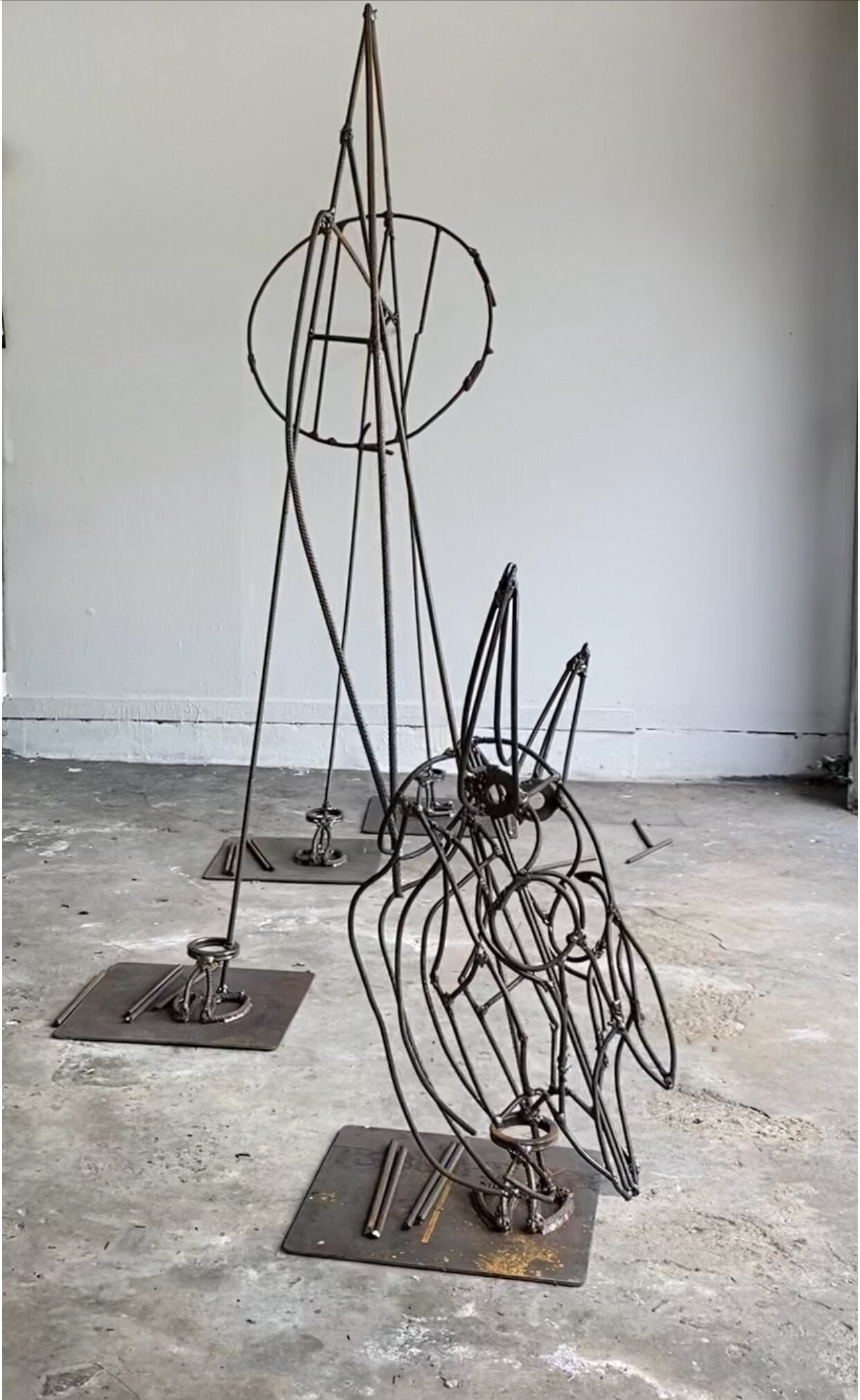Stomach, upper hip bones, and more hump.
He still looks like a hybrid giraffe bison, that is only because his muscles and fur come later.
Your Custom Text Here
Stomach, upper hip bones, and more hump.
He still looks like a hybrid giraffe bison, that is only because his muscles and fur come later.

July 5th.
Attaching the head—
I welded just one connection from the neck to the head. As I assemble other parts of his body I will continue to evaluate the position of the head. I want him to be his reaching to the side searching for the next blades of grass within the reach of his massive head and tongue. With only one weld I can easily cut it off if I decide it is not in the right place or at the right angle. I do enjoy having a bobblehead bison in my garage for a while.
Building the girt—
I happened to have a circular scrap piece of rebar almost the right size. I created it years ago to be a round seat for a faux bois chair that was started and not finished. I turned it into the basis for the bison’s rear hip girth/stomach.
It is a little small, the small size gives me the flexibility to add to it exactly where I want it to protrude. As I get more elements worked out I will make it larger by adding the back hip bones that protrude. t is a lot easier to add pieces as I build him than to cut out pieces.

1 small tack world neck to head. Just to see where I want it.


"If you want to make small changes, change how you do things;
if you want to make big changes, change how you see things."
— In Dirt to Soil, Gabe Brown
How do we restore an ecological balance in Houston? We see Houston in the global ecosystem, see our relationship with wildlife and sea life of the western hemisphere.

Houston
See — Houston can balance humanity and urban wildlife.
Site-Specific installation: Symbiosis is a micro-ecosystem in an important ecological space.
Houston is 600 square miles of mostly privately owned land inhabited by 2.3 million organisms, on the Gulf Coast of South-Eastern North America. Its rainwater runoff feeds the ocean and impacts reefs one hundred miles into the seas. Chemicals from Houston are reported killing reefs 100 miles into the Gulf.

Drain
See — The pesticides, herbicides, and fungicides used to keep Houston’s commercial, residential city and county landscapes manicured are leached by rainwaters that drain into the Gulf of Mexico from our streets.
The plants in Symbiosis do not need chemical inputs to thrive. They have evolved to withstand droughts floods and freezing temperatures.
Located near the lower apex of the triangular-shaped North American continent Houston’s land and water provide nesting, hydration, and nutrition for animals that utilize this critical migratory pathway that funnels migratory life between the northern and southern continents of the western hemisphere. More than one in four birds in the U.S. and Canada has disappeared within my lifetime. Birds play crucial roles in maintaining an ecological balance on the coastal prairie, from eating mosquitos to providing food for scavengers and decomposers.

One In Four Birds In the US Has disappeared In My Lifetime.
See — that birds play crucial roles in maintaining an ecological balance on the coastal prairie, from eating mosquitos to providing food for scavengers and decomposers.
Symbiosis is building living soil that supports bugs, beetles and insects that birds need to feed their young.
A male American Robin sits on the fence at Lawndale at the light of day June 18th, 2021 with Gulf fritillary larvae in his mouth. Until Symbiosis was installed birds flew over Lawndale. The garden was sterile of what modern civilization calls landscape pests/what birds feed their young. The sculpture garden did not offer food or habitat for birds.

Larvae of Gulf Frittilary butterfly – Detail of Symbiosis
See — An important nutrient necessary for birds young to thrive.
With native plants in our urban gardens and commercial outdoor spaces, chemical inputs are not necessary. Chemical-free yards will help bring back the 1107 species once common in the Coastal Prairie.
Houston, the site, has experienced extreme flooding and weather conditions. We are located where once was the Coastal Prairie ecosystem that sequestered Carbon like an upside-down rainforest and absorbed water like a sponge. Of that original landscape, only 1% still exists. And yet, we can see an opportunity to capitalize on Houston’s reputation as the city of energy and cultural diversity. We can mitigate global warming and extreme weather conditions by changing how we see our role in a balanced ecosystem.

Lawndale Symbiosis
Lawndale’s sculpture garden is a micro-ecosystem within an important macro-ecosystem that casts a wide net.

Symbionts
The Passiflora incarnata provides nectar for pollinators. Native bees are the original regenerative farmers, they take nectar and regenerate the flower pollinating the Passiflora incarnata.
This is one species of the 4,000 bees native to the US. (Please note this is not a honey bee. Honey bees are not native to the US. They are part of the industrial farming ecological problem.)
I see an opportunity to create the visual for environmental change. I see hope.
“Look closely at nature and you will understand everything better” - Albert Einstein
Look closely at your micro-ecosystem.
To sustain is not enough. Our civilization has depleted the Earth's soil. It is not enough to sustain a depleted planet; we must all do our part and regenerate soil health to sustain life. Regenerating the Earth’s soil is an ongoing DIY project.
ART CAN ONLY ACTIVATE CHANGE WITH YOUR ADDED PERFORMANCE
—If you care about the environment, help get the conversation going and restore an ecological balance in Houston. Post one image of Houston native plants and or wildlife on Instagram #lawndalesymbiosis and tag two friends.
In addition, forward this to two friends.
Ask two friends to do the same, and ask them to ask two more friends, building a pyramid of activism.
For an enhanced experience viewing Houston’s wildlife and landscape I recommend the citizen science apps
“iNaturalist” and “Seek”.
Every morning I start my day reading an email from Sciencedaily.com. I read the environmental and health-related research news, scanning for articles that relate to my environmental/conservation sculptures and monoprints. The article Living environment affects the microbiota and health of both dogs and their owners Is an exciting read for me. My World of Hum kinetic sculpture was inspired by the impact pesticides have on native bee microflora and one aspect of my current work in progress Symbiosis at Lawndale addresses soil microbes in the sculpture garden.

Visitors are relaxing in the garden during a performance piece at the fall opening event.
Dogs are a large part of urban living and, surprisingly, at Lawndale Art Center. Every other day I stop by Lawndale to study the garden, looking for any changes in the soil, leaves, vines, pond water, and look and listen for any wildlife. Often I run into neighbors of Lawndale with small dogs that visit the garden. Stephanie, her four-year-old daughter, and King Charles Spaniel also spend time together enjoying the outdoors in the garden. Sometimes on Sundays, I bring my labrador Tobi with me. It is hard to judge the impact of urban landscapes on those who visit these green spaces with their pets. Living soil unquestionably has an impact on our microbiomes and our pets as well as supports urban wildlife. One of the most interesting books on the subject of our microbiome is I Contain Multitudes by Ed Yong. Dogs

Basically everything we do impacts our microbiomes. In order to build a healthy immune system a key element in any environment is diversity. My sculpture Symbiosis will be have a positive affect on the microbiota and health of both dogs and their owners who spend time in the garden.
”Root To Water” 24” X 12” X 12” irrigation wheel and root found objects.
“How fleeting are the wishes and efforts of man! how short his time! and consequently how poor will his products be, compared with those accumulated by Nature during whole geological periods.”
—Charles Darwin, Origin of the Species
Root to Water offers hope. The root, placed with the root system up, takes on anthropomorphic characteristics, as the wide spread irrigation wheel’s legs are firmly grounded, the humanized root’s bent over posture and downward pointing arm are alive with discovery, the root’s hair like tendrils are actively rewiring its human anthropomorphic brain. This rewiring is happening across the globe, in the most desolate of landscapes citizen conservationists are studying natural law and finding solutions to their man-made problems.
In Root to Water, the irrigation wheel symbolizes mechanistic systems. The root in its natural state represents ecological systems. With this duo, I propose that modern civilization has reached an advanced stage of industrialization. In order to progress to the next stage of civilization we must heed Darwin’s observation, and answer the question how do we pair mechanical innovation with the systems that have functioned through “whole geological periods.” I placed the root above the wheel supporting Darwin’s view of natural systems superiority to human innovation.
Repurposing two tools from agronomy, Root to Water shifts how we see mechanical systems versus naturally occurring systems. In this sculpture, a modern innovation—a rusting, decorative, human-made irrigation wheel—serves as a pedestal for an organic found object that often goes unseen: a root system. With this pairing, I exhibit man’s historical struggle to transition to an agricultural-based society utilizing human-made innovations that extract natural resources instead of harnessing existing ecological systems that regenerate resources.
Communities across the planet are experiencing extreme cases of natural disasters. Houston has experienced three 500-year floods in three years. The U.S. Army Corps of Engineers completed the Buffalo Bayou and Tributaries Resiliency Study, proposing options for controlling flood waters costing up to $12 billion. The report does not include conveyance options that are local nature-based cost effective solutions.
A growing number of conservationists are using natural systems, specifically roots, as a tool for water transportation, carbon sequestration and as a means to cool the planet. Meanwhile, industrial agricultural produces products that are depleting the organic matter, releasing carbon from the soil, and contributing to global warming. As evidence consider, “Each 1 percent increase in soil organic matter helps soil hold 20,000 gallons more water per acre.” In contrast, industrial methods strip the soil (releasing carbon), use petroleum-based inputs to enrich the soil and kill pests. Root to Water elevates roots as a natural system that transports water, minerals and carbon; stabilizes soil; and is instrumental in cooling Earth’s surface—a live-able solution for global warming.
My research-based art looks at the natural history of living soil and how it can be used to restore natural resources that is not commonly understood. I champion natural solutions to environmental issues with a focus on urban landscapes. Root to Water is part of my Endangered Knowledge work, a body of work in progress.
“Though the problems of the world are increasingly complex, the solutions remain embarrassingly simple.”
—Bill Mollison
Further Reading
-Judith D. Schwartz, The Reindeer Chronicles, Water in Plain Site, and Cows Will Save the Planet
-Kiss the Ground, Directed by Joshua and Rebecca Tickell, with WoodyHarrelson
-Organic Matter Can Improve Your Soil's Water Holding Capacity
-The Loess Plateau was the, most highly erodible soil on earth”
